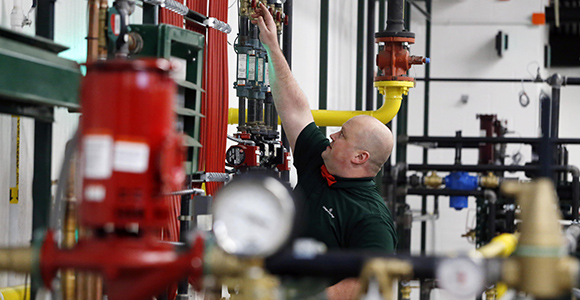
(Photo Credit: COD Newsroom/Flickr)
If you are a California millennial wondering what to do with your life and you’re into mechanical things, you should go learn about HVAC (heating, ventilating and air conditioning).
A meeting of industry, labor and community college leaders in Irwindale heard on Friday that there’s an immediate need for 1,200 workers in California, half of those in Los Angeles, Orange, Riverside and San Bernardino counties.
And, there aren’t nearly enough qualified workers in the pipeline to fill the need. On top of that, this situation isn’t a one-time workforce challenge—not nearly.
As one business owner told the group, ”baby boomers are leaving the industry for retirement.” Thus, these openings aren’t just around this year—these numbers will continue to grow for the foreseeable future.
How to replace them was the theme of the meeting sponsored by the Los Angeles and Orange County Regional Consortium, which represents 27 community colleges in those two large counties and works on regional leadership and expertise on career technical education and workforce development issues.
What’s exacerbating the acute need for HVAC jobs like construction managers, building operators, energy and efficiency analysts, and lighting control technicians is California’s Clean Energy and Pollution Act, known as SB 350.
And while buildings are becoming more efficient, almost half of the energy consumed in U.S. commercial buildings goes toward heating, cooling and lighting.
“Architects and building managers are looking at new technologies to reduce consumption and they need people trained in these new technologies,” said Bruce Noble, Los Angeles deputy sector navigator for the Energy, Construction & Utilities Sector at California Community Colleges.
Friday’s audience included representatives from many employers including the major California utilities, underscoring the critical and urgent need for a trained workforce.
The answers won’t come overnight, said Jim Caldwell, statewide sector navigator for the Energy, Construction & Utilities Sector at California Community Colleges. But progress is already evident in preparing what is being called the “net-zero workforce” which is trained to use technologies designed to reduce energy and resource use.
There was an interesting exchange regarding the need for internships this summer: Tim Aldinger of the Foundation for California Community Colleges told the group “we’d like to leave here today with you ready to offer an internship to 20 students.” The Foundation has a program that would cover the human resources, payroll and liability costs.
Many employers, indicating the urgent need, told Aldinger they are ready right now to hire qualified students as part-time workers for this summer, without the need to go through the bureaucracy to make them interns.
The Community Colleges can also play a role in retraining. An estimated 50,000 workers across California need continuing education for the new skills needed in this industry, which is changing fast because of advances in technology.
To keep up with changes, Caldwell said “we can’t just offer training, real employer engagement is needed.”
That theme was echoed by a community college workforce leader who called for more “externships,” in which high school and college teachers would visit businesses to learn about the latest technologies and techniques.
Then the teachers could go back to their colleges and develop curriculum that will better prepare students.
Historically, the problem that arose after one college instructor developed an up-to-date course is that it would be virtually impossible to share with other campuses. That’s changing.
“Faculty networks are being developed so that when a new course is developed, faculty members at other colleges can bring it through their own school’s approval,” said Caldwell.
The California Economic Summit has identified the state’s workforce needs as a key challenge. In its 2016 Roadmap to Shared Prosperity, the Summit has promoted the need for one million more middle skill workers in California over the next decade.
Friday’s meeting regarding HVAC opportunities and the similar workforce challenges existing in a number of other sectors of California’s large and ever-changing regional economies underscore the importance of getting this right.

